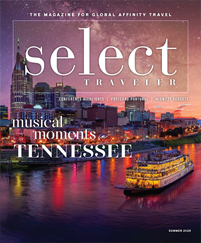Whether it’s seeing ancient Texas cave drawings at the Witte Museum or tasting a sample of the city’s culinary scene with San Antonio Detours, groups can experience culture old and new in San Antonio. The River City celebrates the variety of people who helped shape the charming-yet-modern destination with a variety of historic sites, museums, shopping experiences and tours.
The city garnered global recognition for its historic preservation efforts in 2015 when the Alamo and the San Antonio Missions National Park were designated UNESCO World Heritage Sites. Groups can explore the city’s past at these intriguing and beautiful Spanish colonial missions.
San Antonio’s colorful past and present comes to life at the following cultural attractions.
Spanish Colonial Missions
Catholic religious groups came to Texas in the 17th century to spread their faith among the local indigenous groups. Five of their stone mission churches remain in San Antonio.
“People domestically don’t know we have a UNESCO World Heritage Site,” said Casandra Matej, president and CEO of Visit San Antonio. “Our five Spanish colonial missions are among the most historical and cultural icons around the world. They are on the same list as the pyramids of Egypt, so their importance is internationally recognized.”
Visitors to the Alamo Mission can discover its early history and learn about the famous Battle of the Alamo that took place there. The site is one of the most popular historic attractions in the United States, with over 4 million visitors each year. Groups can tour the chapel and long barracks to see weapons, artifacts and a large diorama that re-creates the compound as it was in 1836.
Each of the four missions at the San Antonio Missions National Historic Park tells a different piece of the Spanish colonial mission story. At the well-preserved Mission Concepcion, groups can examine original fresco paintings and awe-inspiring stone architecture.
Mission San Jose paints a more complete picture of mission life, with Indian quarters, workshops, a granary, a visitors center and a bookstore. Groups can attend a ranger-led program or watch the park film. Mission San Juan grows historical crops with a 300-year-old watering system, and the Mission Espada showcases brick-lined structures and woven arts.
Market Square
Bright colors, spirited music, handmade crafts and a tradition reaching back to the 1820s make Market Square much more than a simple shopping destination. One of the largest Mexican markets outside Mexico, it features over 100 locally owned shops and restaurants in a three-block section of downtown San Antonio.
“Market Square is really fun,” said Matej. “You have mariachi bands roaming around and playing. There are stores there that have been passed down in the family for seven generations. It is a lively place with the best-tasting food in the city.”
Groups can shop for authentic Talavera pottery, leather goods, jewelry and other handmade crafts. Working artists not only showcase their skills but also give demonstrations for shoppers, who can watch them create pottery, paintings and other crafts.
Mexican aromas also tempt visitors at traditional restaurants and other eateries. Mariachi and Tejano musicians perform year-round, and visitors will find folklorico dancing frequently taking place during the weekends.
Texas Folklife Festival
Though one might expect festivals featuring Mexican dancing in San Antonio, the Texas Folklife Festival at the Institute of Texan Culture also showcases the folk traditions and foods from Ukraine, Scotland, Lebanon and over 40 other countries.
“We have a lot of Spanish and Mexican influence in our culture,” said Matej. “People do not realize we also had a lot of German settlers as well as immigrants from many other countries. When you mix in all those cultures, it makes for interesting culinary and art.”
The Texas Folklife Festival runs for three days each June to honor the many cultures represented in the state of Texas. Groups can attend internationally inspired concerts, dances and craft demonstrations. They can also participate, with opportunities for working alongside basket weavers, leather workers, potters and much more.
The event is sponsored by the Institute of Texan Cultures, which celebrates the state’s cultures throughout the year with 65,000 square feet of interactive exhibits. Groups can learn about Texas’ Native American tribes, as well as Irish, German and other immigrants who played key roles in Texas history.
San Antonio Detours
Many visitors take photos before they sample the dishes offered on a San Antonio Detours food adventure. The tour company’s Taste San Antonio Food Tour offers a progressive dinner across the city to sample both classic dishes and newer favorites.
The three-hour tour touches on San Antonio’s growing culinary scene, cultural food traditions and history. Local seafood, classic Mexican dishes and handmade desserts make frequent appearances on the tour’s lineup.
In addition, the company offers a BBQ and Brews tour that highlights some of the city’s dozens of barbecue joints. The tours also stop at various craft breweries for samples of the city’s nationally acclaimed brews.
San Antonio Detours also takes groups beyond the city limits for wine tastings in the nearby Texas Hill Country.
Witte Museum
To see how San Antonio began, groups can examine cave man paintings and dinosaur bones at the Witte Museum.
“The Witte Museum is a combination of a Texas heritage museum and a science museum,” said Matej. “There are a lot of interactive aspects in the museum. They have invested a lot of money into the facility. It sits on the banks of the San Antonio River. It is just beautiful.”
Established in 1926, the museum tells the stories of Texas from prehistory to the present. Historic artifacts, photographs, Texas art and textiles cover the human history, and dinosaur bones and Texas wildlife dioramas reflect the state’s natural environment. Among the favorite displays are a skeleton of the meat-eating Acrocanthosaurus, 4,000-year-old cave art and videos detailing interesting stories from the state’s history.
The museum invites guest participation with regular demonstrations on various topics, including cooking activities, live animal encounters and replicated traditions of Texas’ prehistoric hunter-gather tribes.









